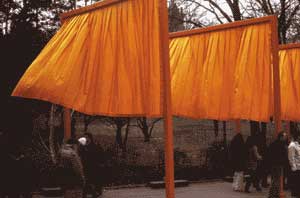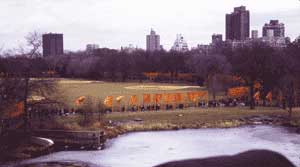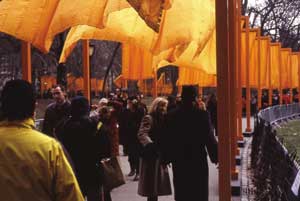You are walking down a promenade of saffron, miles long. Dreamlike. You’ve been here, but it is different now. Walking through a changed space. Golden billows of fabric surround you. In front, behind, and hovering just above your head. Gleaming sunlight filters through the fabric. There are no leaves on the trees and the fabric dances against the branches. You are not alone. Thousands and thousands of people, many smiling, some talking, some playing, are meandering with you. In the distance you notice the contours of a walkway, defined by the river of saffron, but invisible days before.
The scene changes. It is night. It is mysterious and unfamiliar, but safe and welcoming. There are still miles of fabric in front of you, only the texture is different. Instead of sunlight, blue and pink halogen streetlights reflect off the cloth, giving it another feeling. In the distance you see a red stoplight next to a billowing orange curtain. There is a fog in the air. Now there is snow and the orange yellow changes again, set against the sea of white. Your senses are aware. You notice things you haven’t seen before.
*****
For 16 days, beginning February 12, 2005, New York was home to The Gates, Central Park, New York City, 1979-2005, a magnificent artwork by Christo and Jeanne-Claude. It consisted of 7,503 16’ tall gates situated along the 23 miles of Central Park’s walkways, each gate spanning the width of the path and positioned about 12’ from the next gate. Hanging from the top of each gate was a 9’ pleated saffron-colored fabric that spanned the width of the gate. The fabric was only attached at the top so it was free to blow in the wind. The entire park was transformed into a giant artwork, which was to be seen and experienced by walking through it. It was one of the most significant artworks in the city for years.
Christo and Jeanne-Claude produce site-specific public installations all over the world whose meaning is wide-ranging. Often their work encourages viewers to think about monuments, icons, public space, and tradition in unexpected ways. They work on a scale which artists rarely think of, and few, if any, ever realize. Using fabric, they have wrapped the Reichstag in Germany, surrounded islands in Biscayne Bay near Miami, and run a curtain 24« miles from the Pacific Ocean along the rolling hills of Sonoma and Marin counties. These transformations and others they have made by wrapping bridges, monuments and trees, creating walls with oil drums, and placing gigantic umbrellas in the landscape, create a magical new beauty and enable viewers to perceive the space in new ways and with new understanding. They have created works of joy that have been seen for free by literally millions of people and have changed the way many see art itself.
Most of their work utilizes fabric, and the work is generally abstract on some level. Like their other work, The Gates doesn’t have one meaning or a literal interpretation. Work that is abstracted like this allows viewers to bring a range of experience to the work. Attempting to fix one and only one reading of the work both misses the point and does the work an injustice.
Christo and Jeanne-Claude often talk about their work in purely technical and formal terms (1,067,330 miles of fabric, 5,290 tons of steel for the bases, 315,491 linear feet of vinyl for the poles of the gates, etc.) While talk in these terms gives a sense of the enormous scale of the work—a scale which few viewers get to see—it seems to miss one of the essential points of the work—its beauty.
The Gates was a work of awesome beauty. And it was available for all residents and visitors to NY to see.
*****
Though there is not only one particular reading or meaning to the work, The Gates does touch on and explore memory. People who were fortunate enough to see this art will probably never view Central Park in the same way again. There will always be the memory of the amazing gates. Viewers perception of the Park was forever changed—there will always be an absence—something always missing. But we were changed for the better for both the experience and the absence that is now in the park. It is like the memory of a loved grandparent who has died, the reminiscences of a friend from youth, your wedding day, the first time you made love. All are in the past; by a day, a week, perhaps years—but the memory remains. You are changed by the experience and The Gates was a fleeting thing that you couldn’t hold in your hand or fix in time, but which continues to live in your mind. And knowing that it would be gone even as you walked through it, you had the sense of experiencing something you knew would not last.
The temporary nature of the work is essential to it and to all the large-scale public work of Christo and Jeanne- Claude. The Gates was like the life a butterfly. It lasted a mere 16 days. The fleeting duration encouraged people to rush to it and to really look at and appreciate the art itself, but also the importance and beauty of other temporary things. When a child is born, friends and family rush to see the new boy or girl. At age 3 or 7 or 15, or even 4 months, the child will be special and loved, but they will never be 3 days old again—and the special moment surrounding their birth will be gone. The Gates encouraged viewers to appreciate things that are really unique and special and recognize that change is constant so we must be attuned to what is rare when we have the chance.
The Gates was larger than a major airport and it cost as much as a low-budget Hollywood film to make. Some have commented that this is an extreme expense (which the artists paid for entirely themselves from the sale of other art) when people don’t have homes and food and have argued that only intellectuals would understand it.
But I think it is important to appreciate art, science, and other intellectual works that are not tied in such a direct way to the ongoing struggles of the people.
This art doesn’t house or clothe people and it doesn’t directly address such social questions. And that is fine. We need work that exposes the horrors of the day and work that imagines a whole different future. But the world and art would be lifeless and boring without a broad range of work that allows us to see, hear, and imagine the world differently.
Christo and Jeanne-Claude have confidence in ordinary people’s ability to grasp and enjoy contemporary art—at least the kind of work that they make. And their confidence is well founded. A million people saw The Gates and clearly the overwhelming majority who saw it enjoyed the work and grasped the essence of it. People with more familiarity with contemporary art may see different aspects of it, but this is true with many great works; they operate and function on different levels and address questions in complex ways that leave room for a range of audiences to experience and discuss.
*****
The public nature of the work, that it was in the heart of New York for all to see for free, poses real questions of who art is for and who the public parks and space are for.
Central Park was conceived of as a commons —a public space accessible to all. This use has been contested over the years—it was the park that hosted Be-Ins, happenings, and concerts in the ’70s and which the powers that be tried to prevent people from gathering in to oppose the Republican National Convention in 2004. In an increasingly privatized and restricted world, The Gates called on all manner of people to collectively experience this public space and art. This work was a real gift to the people.
Recently, Bruce Springsteen inducted U2 into the Rock and Roll Hall of Fame. In that speech, he said: "A great rock band searches for the same kind of combustible force that fueled the expansion of the universe after the big bang. You want the earth to shake and spit fire. You want the sky to split apart and for God to pour out. It’s embarrassing to want so much and to expect so much from music, except sometimes it happens: the Sun Sessions, Highway 61, Sgt. Peppers, the Band, Robert Johnson, Exile On Main Street, Born To Run.the Sex Pistols, Aretha Franklin, the Clash, James Brown; the proud and Public Enemy’s It Takes a Nation of Millions to Hold Us Back. This is music meant to take on not only the powers that be, but on a good day, the universe and God himself if he was listening."
While Springsteen was referring to music, in its own way all great art strives to tap into this spirit. While there is no god, the audaciousness of such artists inspires us, challenges long-held beliefs, threatens status quos large and small, shakes us to our cores and bring us great joy in unexpected ways.
Art has been essential to humanity ever since we had the time to tell stories, write poems, or paint on cave walls. Art is an essential part of what makes us human. And visual art like The Gates opens up ways of thinking that other forms of communication do not. It is often non-literal and non-linear, requiring an audience to utilize their own perception and thinking to draw conclusions and meaning from the images that artists have created for us.
In the future, under socialism, and in qualitatively greater ways once people have achieved a communist world of freely associating human beings, imagination will be taken to new heights. Our need to be amazed, our awe and wonder at our world and the universe will inspire and guide new discovery, experimentation, and transformation of that world. And art like The Gates is a harbinger of what is possible when artists dare to dream the impossible and then make their dreams real.
Christo and Jeanne-Claude are artists with real heart. They push the envelope, even their own envelope, of what art can be. The Gates expanded new ground for art. The work is gone, but a beautiful memory lingers.
Dread Scott is a multidisciplinary artist whose work addresses questions that are part of the public discourse. He first received national attention in 1989, when his art became the center of controversy over its use of the American flag. President Bush (the first) declared his artwork What is the Proper Way to Display a U.S. Flag?"disgraceful" and the entire U.S. Senate denounced this work as they passed legislation to "protect the flag." His work is exhibited in galleries and museums in the U.S. and internationally.


